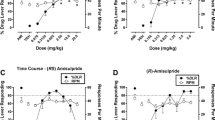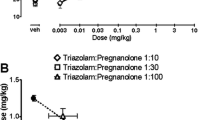Abstract
Rats were trained to discriminate injections of racemic pentobarbital (5.0 mg/kg) from saline in a two-lever drug discrimination task. After stable discrimination performance was attained, stimulus generalization studies were conducted with another barbiturate (barbital), benzodiazepine derivatives (diazepam and chlordiazepoxide), pyrazolopyridine derivatives (etazolate, cartazolate, and tracazolate), and a triazolopyridazine (CL 218, 872). The pentobarbital stimulus generalized to all of these compounds, except cartazolate. In addition, the administration of the benzodiazepine receptor antagonist flumazepil prior to benzodiazepine or triazolopyridazine administration produced a dose-related antagonism of each generalization. In contrast, the administration of flumazepil before barbiturate or pyrazolopyridine (i.e., etazolate or tracazolate) injection resulted in no attenuation of these generalizations. The results indicate that while certain barbiturates, benzodiazepines, pyrazolopyridines, and triazolopyridazines are capable of producing similar stimulus effects, the behavioral actions of these agents can be differentiated on the basis of their susceptibility to antagonism by flumazepil.
Similar content being viewed by others
References
Barry H, III, Krimmer EC (1978) Similarities and differences in discriminative stimulus effects of chlordiazepoxide, pentobarbital, ethanol, and other sedatives. In: Colpaert FC, Rosecrans JA (eds) Stimulus properties of drugs: ten years of progress. Elsevier/North Holland Biomedical Press, Amsterdam, p 31
Barry H, III, Krimmer EC (1979) Differential stimulus attributes of chlordiazepoxide and penntobarbital. Neuropharmacology 18:991–998
Beer B, Klepner CA, Lippa AS, Squires RF (1978) Enhancement of 3H-diazepam binding by SZ 65,396: A novel anti-anxiety agent. Pharmacol Biochem Behav 9:849–851
Bonetti EP, Pieri L, Cumin R, Schaffner R, Pieri M, Gamzu ER, Muller RKM, Haefely W (1982) Benzodiazepine antagonist Ro 15–1788: Neurological and behavioral effects. Psychopharmacology 78:8–18
Colpaert FC, Desmedt LKC, Janssen PAJ (1976) Discriminative stimulus properties of benzodiazepines, barbiturates and pharmacologically related drugs; relation to some intrinsic and anticonvulsant effects. Eur J Pharmacol 37:113–123
Finney DJ (1952) Probit analysis. Cambridge University Press, London
Herling S, Shannon H (1982) Ro 15–1788 antagonizes the discriminative stimulus effects of diazepam in rats but not similar effects of pentobarbital. Life Sci 31:2105–2112
Herling S, Valentino RJ, Winger GD (1980) Discriminative stimulus effects of pentobarbital in pigeons. Psychopharmacology 71:21–28
Jarbe TUC (1976) Characteristics of pentobarbital discrimination in the gerbil: Transfer and antagonism. Psychopharmacology 49:33–40
Klepner CA, Lippa AS, Benson DI, Sano MC, Beer B (1979) Resolution of two biochemically and pharmacologically distinct benzodiazepine receptors. Pharmacol Biochem Behav 11:457–462
Leeb-Lundberg F, Snowman A, Olsen R (1981) Pertubation of benzodiazepine receptor binding by pyrazolopyridines involves picrotoxin/barbiturate receptor sites. J Neurosci 1:471–477
Lippa AS, Critchett D, Sano MC, Klepner CA, Greenblatt EN, Coupet J, Beer B (1979) Benzodiazepine receptors: Cellular and behavioral characteristics. Pharmacol Biochem Behav 10:831–843
Lippa AS, Meyerson LR, Beer B (1982) Molecular substrates of anxiety: Clues from the heterogeneity of benzodiazepine receptors. Life Sci 31:1409–1417
Mohler H, Burkard WP, Keller HH, Richards JG, Haefely W (1981) Benzodiazepine antagonist Ro 15–1788: Binding characteristics and interaction with drug-induced changes in dopamine turnover and cerebellar cGMP levels. J Neurochem 37:714–722
Olsen RW (1981) GABA-benzodiazepine-barbiturate receptor interactions. J Neurochem 37:1–13
Patel JB, Malick JB (1982) Pharmacological properties of tracazolate: A new nonbenzodiazepine anxiolytic agent. Eur J Pharmacol 78:323–333
Paul SM, Skolnick P (1982) Comparative neuropharmacology of antianxiety drugs. Pharmacol Biochem Behav 17:37–41
Polc P, Laurent JP, Scherschlicht R, Haefely W (1981) Electrophysiological studies on the specific benzodiazepine antagonist Ro 15–1788. Naunyn-Schmiedebergs Arch Pharmacol 316:317–325
Skolnick P, Moncada V, Barker JL, Paul SM (1981) Pentobarbital: Dual actions to increase brain benzodiazepine receptor affinity. Science 211:1448–1450
Skolnick P, Paul SM (1982) Benzodiazepine receptors in the central nervous system. Int Rev Neurobiol 23:103–140
York JL (1978) A comparison of the discriminative stimulus effects of ethanol, barbital, and phenobarbital in rats. Psychopharmacology 60:19–23
Young R, Dewey WL (1982) In: Colpaert FC, Slangen JL (eds) Drug discrimination: applications in CNS pharmacology. Elsevier Biomedical Press, Amsterdam, pp 235–240
Young R, Glennon RA, Dewey WL (1983) Discriminative stimulus effects of pentobarbital and diazepam. Fed Proc 42:1168
Young R, Glennon RA, Dewey WL (1984) Stereoselective stimulus effects of 3-methylflunitrazepam and pentobarbital. Life Sci 34:1977–1983
Author information
Authors and Affiliations
Rights and permissions
About this article
Cite this article
Young, R., Glennon, R.A. & Dewey, W.L. Effects of pyrazolopyridines and a triazolopyridazine on the pentobarbital discriminative stimulus. Psychopharmacology 93, 494–497 (1987). https://doi.org/10.1007/BF00207241
Received:
Revised:
Issue Date:
DOI: https://doi.org/10.1007/BF00207241




